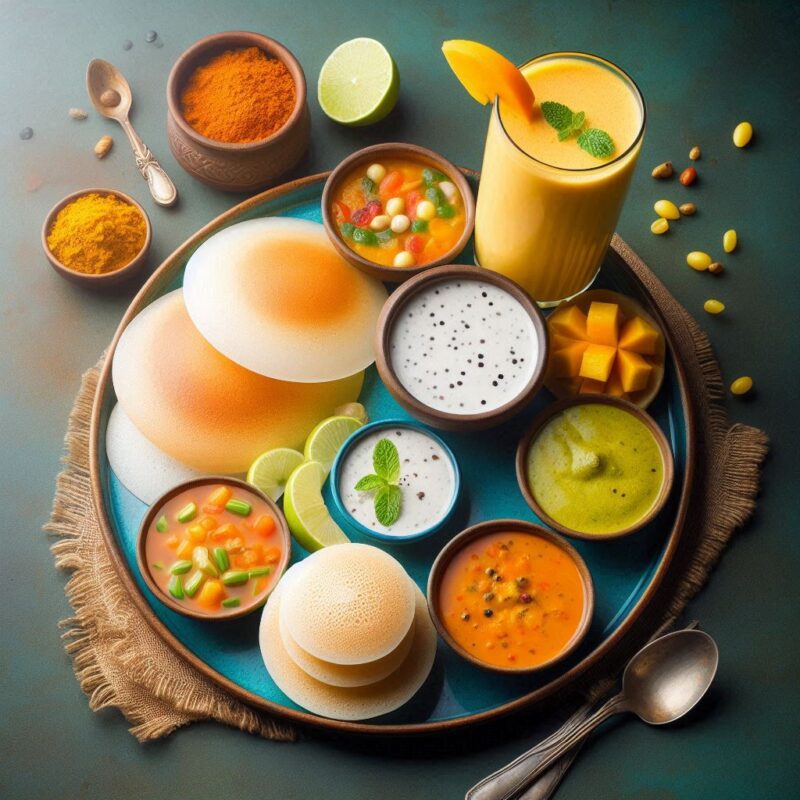Healthy Recipes
Healthy Indian Breakfast

Healthy Indian Breakfast is a great way to start your day with a nutrient-packed meal that fuels energy, provides necessary nutrients, and keeps you feeling full until lunchtime. Traditional Indian breakfasts can be adapted to be both nutritious and delicious, focusing on whole grains, proteins, and healthy fats while minimizing refined sugars and fried foods.
Key Components of a Healthy Indian Breakfast:
- Whole Grains: Opt for whole grains like oats, whole wheat, semolina (sooji), millets, and quinoa. These provide sustained energy and fiber, which helps digestion.
- Protein: Include sources like legumes, lentils, eggs, paneer, tofu, and dairy for muscle health and satiety.
- Healthy Fats: Use small amounts of healthy fats such as ghee, olive oil, or coconut oil, and include nuts and seeds for additional nutrients.
- Vegetables & Fruits: Fresh vegetables and seasonal fruits add fiber, vitamins, and antioxidants.
- Spices: Use spices like turmeric, cumin, coriander, and ginger for their anti-inflammatory and digestive benefits.
Healthy Indian Breakfast Options:
1. Oats Idli
- Ingredients: Rolled oats, semolina (sooji), yogurt, grated carrots, and spices like mustard seeds, curry leaves, and cumin.
- Benefits: A twist on traditional idli, using oats adds more fiber and heart-healthy nutrients. Serve with a side of coconut chutney or sambar for extra flavor and nutrients.
2. Vegetable Dalia (Broken Wheat) Upma
- Ingredients: Broken wheat (dalia), mixed vegetables (carrots, peas, beans), curry leaves, mustard seeds, and green chilies.
- Benefits: Dalia is rich in fiber and vitamins, and adding vegetables boosts the nutrient profile. It’s a wholesome and light meal that keeps you full for longer.
3. Moong Dal Cheela (Lentil Pancake)
- Ingredients: Ground yellow moong dal, cumin, green chilies, and coriander leaves.
- Benefits: A high-protein, gluten-free option that’s easy to make. Serve with green chutney or yogurt for a complete breakfast.
4. Ragi (Finger Millet) Porridge
- Ingredients: Ragi flour, milk (or plant-based milk), and jaggery or honey for sweetness.
- Benefits: Ragi is a powerhouse of calcium, iron, and fiber. This porridge can be sweetened naturally and garnished with nuts or seeds for added nutrition.
5. Avocado Paratha
- Ingredients: Whole wheat flour, mashed avocado, cumin powder, and fresh coriander.
- Benefits: Avocados add healthy fats and a creamy texture to traditional paratha, while whole wheat flour adds fiber. Serve with yogurt or a chutney for a complete, balanced breakfast.
6. Masala Oats
- Ingredients: Rolled oats, mixed vegetables (onions, tomatoes, peas), turmeric, cumin, and coriander.
- Benefits: This savory oats dish is packed with fiber and nutrients from both oats and vegetables, providing a heart-healthy and filling start to the day.
7. Poha (Flattened Rice) with Vegetables
- Ingredients: Flattened rice (poha), mustard seeds, curry leaves, turmeric, peanuts, and mixed vegetables (carrots, peas, onions).
- Benefits: Poha is light and easily digestible, and when combined with vegetables and peanuts, it becomes a nutritious, balanced meal rich in fiber, proteins, and healthy fats.
8. Egg Bhurji (Scrambled Eggs) with Whole Wheat Toast
- Ingredients: Eggs, onions, tomatoes, green chilies, turmeric, and whole wheat toast.
- Benefits: Eggs are a great source of protein, and when cooked with veggies and spices, they make a flavorful and nutrient-rich breakfast. Whole wheat toast adds fiber and complex carbs.
9. Sprouts Salad
- Ingredients: Sprouted moong beans, onions, tomatoes, cucumber, and lemon juice.
- Benefits: A protein-packed, raw salad that’s light but filling. Sprouts are nutrient-dense and easy to digest, and the salad provides a burst of vitamins, minerals, and fiber.
10. Ragi or Multigrain Dosa
- Ingredients: Ragi or multigrain flour, yogurt, and spices.
- Benefits: Dosa made from ragi or multigrain flour offers a good balance of protein, calcium, and fiber. It’s a lighter and healthier alternative to traditional rice-based dosa. Serve with coconut chutney or sambar.
Tips for Making Your Breakfast Healthier:
- Cut Down on Refined Sugars: Avoid using refined sugars. Instead, use natural sweeteners like honey, dates, or jaggery.
- Incorporate Seasonal Produce: Include fresh, seasonal fruits and vegetables to maximize nutrients.
- Mind Portion Sizes: While these breakfasts are healthy, maintaining portion control ensures you get the right balance of nutrients without overeating.
- Stay Hydrated: Start your day with a glass of warm water, or have herbal tea with breakfast.
- Minimize Deep-Fried Foods: If you’re craving traditional dishes like puri or vada, opt for healthier cooking methods like steaming, grilling, or using less oil.
Beverage Ideas:
- Herbal Tea: Opt for green tea, tulsi tea, or ginger lemon tea for their antioxidant properties.
- Masala Chaas (Spiced Buttermilk): Made with low-fat yogurt, cumin, and coriander, it aids in digestion and adds probiotics.
- Smoothies: A fruit-based smoothie with yogurt, spinach, and flaxseeds can be a great addition to your breakfast.
These options ensure that your breakfast is not only filling but also rich in essential nutrients, helping you to maintain energy levels throughout the day.